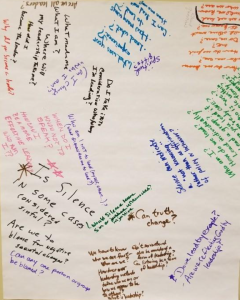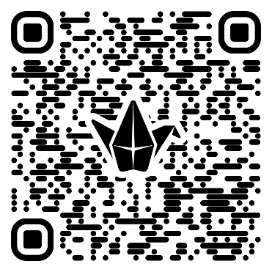 I want to make the case for the use of instructional strategies that increase student engagement. As experts in our content areas, we have a wealth of knowledge and resources we want to place in the hands of our students. We find, though, that time is often of the essence and we may shift away from student-centered learning opportunities to ensure that the information and our knowledge surrounding that topic are shared.
I want to make the case for the use of instructional strategies that increase student engagement. As experts in our content areas, we have a wealth of knowledge and resources we want to place in the hands of our students. We find, though, that time is often of the essence and we may shift away from student-centered learning opportunities to ensure that the information and our knowledge surrounding that topic are shared.
I would suggest that our students want to learn WITH us, rather than have us do it FOR them. We do assign homework, projects, reports, and essays based on readings and lectures to gather data about what students know with regard to our content and key themes of our courses, but what if we also looked to provide that information with key strategies that would enable students to unpack the texts, images, videos, simulations, AND provide space for them to learn WITH us—to engage as a community of learners where all can be seen, heard, and understood.
We have the content, we have the outcomes, and we have the means by which we want students to demonstrate those outcomes—eventually becoming experts—but sometimes our students need scaffolding to support their learning, to enable them to know how to best engage with the content and with each other in this post-Covid world. We, too, as learners have our own means of scaffolding our learning. What if we allowed students into that world as well? Subject matter content is readily at students’ fingertips, but do they know how to access and use it effectively to grow their understanding of their field, their community, and the world around them? Students must be able to effectively engage with, analyze and think critically about their fields of study in order to become highly effective leaders in their respective fields.
As we live more fully in this post-Covid digital age, our quality of engagement in real life has waned. As a result, we, as a community of learners, must work to reignite face-to-face interpersonal skills that support civic and civil discourse through inquiry, active listening, and inclusive engagement. Included in this blog post is a link to strategies from the National School Reform Faculty, the Center for Leadership and Educational Equity, as well as articles from across the country that center around implementation of strategies that scaffold student learning and can be used across content areas.
While I have tried all of the strategies included here, I must say that for enhancing student inquiry and critical thinking, the Question Formulation Technique (QFT) has been most effective. Dan Rothstein and Luz Santana, in their book, Make Just One Change (2014), note that if students own their own learning—ask their own questions—they will not only learn more but be more effective citizens, community members, leaders, and change makers. The authors and codirectors of the Right Question Institute also note that the Question Formulation Technique provides a level playing field by providing equity and access for each and every student to grow their critical thinking, inquiry, and reflection skills. I have paired this strategy to preview a topic, support thesis generation, as well as to brainstorm more broadly around social, political, moral, and spiritual issues.
 My latest use of QFT has been within my First Year Seminar—Live. Lead. Learn.—where students spend the semester engaging with historic and present-day scholars, writers, activists, and artists as they relate what it meant to live, lead, and learn in their generation while we simultaneously unpack what it means for us to do the same in this present age. While this strategy supports effective questioning and critical thinking skills, it also provides my students with space to consider their own opportunities for leadership in light of who they are and how they, in turn, want to lead within their respective fields of study. QFT involves students generating questions (without fear or favor) around a question focus (provided by the instructor). In Live. Lead. Learn., our question focus while using this strategy is: “Who we are is how we lead,” by Dr. Brené Brown from her book Dare to Lead (2018). Once students have spent time generating questions based on the question focus, they then select a question that they want to use to support their thesis creation and research for the “Leaders in Their Field” essay. This essay asks that students research leaders in their chosen fields to determine what leaders in their field look and sound like so that students can then posit who they are and how they intend to lead in their chosen fields. There is a sample of student generated questions included here.
My latest use of QFT has been within my First Year Seminar—Live. Lead. Learn.—where students spend the semester engaging with historic and present-day scholars, writers, activists, and artists as they relate what it meant to live, lead, and learn in their generation while we simultaneously unpack what it means for us to do the same in this present age. While this strategy supports effective questioning and critical thinking skills, it also provides my students with space to consider their own opportunities for leadership in light of who they are and how they, in turn, want to lead within their respective fields of study. QFT involves students generating questions (without fear or favor) around a question focus (provided by the instructor). In Live. Lead. Learn., our question focus while using this strategy is: “Who we are is how we lead,” by Dr. Brené Brown from her book Dare to Lead (2018). Once students have spent time generating questions based on the question focus, they then select a question that they want to use to support their thesis creation and research for the “Leaders in Their Field” essay. This essay asks that students research leaders in their chosen fields to determine what leaders in their field look and sound like so that students can then posit who they are and how they intend to lead in their chosen fields. There is a sample of student generated questions included here.
 As you consider QFT as well as the additional strategies you find in this Padlet, reflect first on yourself as a learner; engage in a few of these strategies firsthand to note equitable access and ease of use for you. From there, consider a text (image, video, simulation, etc.) that you would like to empower your students to engage in with you and with one another. As you do, note how these protocols and strategies will radically alter the engagement, critical thinking, inquiry, and reflection skills of each and every one of your students as you work to create scientists, historians, educators, nurses, engineers, artists, musicians, accountants, managers, coders, cyber security experts, counselors, and theologians. By engaging WITH our students around our content rather than merely relying on the creation of engaging content FOR our students, we will see a rise in caring community members, thoughtful leaders, and engaged change makers who are positively impacting their communities locally and globally.
As you consider QFT as well as the additional strategies you find in this Padlet, reflect first on yourself as a learner; engage in a few of these strategies firsthand to note equitable access and ease of use for you. From there, consider a text (image, video, simulation, etc.) that you would like to empower your students to engage in with you and with one another. As you do, note how these protocols and strategies will radically alter the engagement, critical thinking, inquiry, and reflection skills of each and every one of your students as you work to create scientists, historians, educators, nurses, engineers, artists, musicians, accountants, managers, coders, cyber security experts, counselors, and theologians. By engaging WITH our students around our content rather than merely relying on the creation of engaging content FOR our students, we will see a rise in caring community members, thoughtful leaders, and engaged change makers who are positively impacting their communities locally and globally.